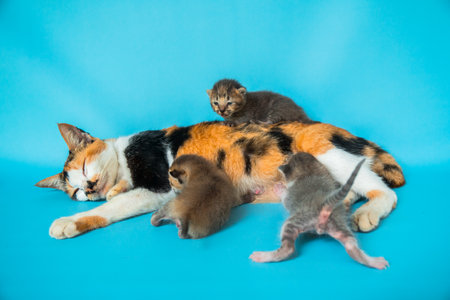1. Understanding a Cats Natural Grooming Habits
Cats are naturally fastidious groomers, often spending hours each day cleaning themselves. This self-grooming behavior is not just about staying clean—it plays a crucial role in their overall health and well-being.
How Cats Keep Themselves Clean
Cats use their tongues, teeth, and paws to remove dirt, debris, and loose fur from their coats. Their tongues have tiny, hook-like structures called papillae that help detangle fur and distribute natural oils evenly across their skin. This process helps keep their coat smooth, shiny, and free of mats.
Benefits of Self-Grooming
| Benefit | Description |
|---|---|
| Removes Dirt & Debris | Cats lick their fur to eliminate dust, dirt, and other unwanted particles. |
| Regulates Body Temperature | Their saliva cools them down when it evaporates from the fur. |
| Reduces Parasites | Grooming helps remove fleas and other small pests before they become a problem. |
| Prevents Matting | Regular licking keeps the fur from tangling and forming painful mats. |
| Provides Comfort & Stress Relief | Grooming is also a soothing activity that helps cats feel calm and secure. |
When Self-Grooming Isnt Enough
While most cats do a great job of keeping themselves clean, there are situations where additional grooming may be necessary. Long-haired breeds like Persians or Maine Coons are more prone to matting and may need brushing to prevent tangles. Senior cats or overweight cats might struggle to reach certain areas of their bodies, leading to hygiene issues that require human assistance.
Signs Your Cat May Need Extra Grooming Help:
- Matted or tangled fur that doesn’t improve with self-grooming
- An increase in hairballs due to excessive shedding
- A greasy or dirty coat, especially around the tail area
- Dandruff or flaky skin buildup
- A decrease in self-grooming behavior due to age or mobility issues
The Role of Owners in Cat Grooming
Even though cats are skilled at grooming themselves, pet owners should monitor their cat’s coat condition regularly. Brushing your cat can help reduce shedding, prevent hairballs, and strengthen your bond with your feline friend. In some cases, professional grooming may be necessary for heavily matted fur or hygiene-related concerns.
Understanding your cat’s natural grooming habits can help you determine when additional care is needed. By paying attention to their coat condition and grooming behaviors, you can ensure your cat stays healthy and comfortable.
2. Do Cats Really Need Haircuts?
Unlike dogs, most cats do not require regular haircuts. Their fur is naturally designed to regulate body temperature and provide protection. However, in some cases, trimming their fur can be beneficial for their health and comfort.
When Might a Cat Need a Haircut?
While routine haircuts are unnecessary for most cats, there are certain situations where grooming may help:
1. Excessive Matting
Long-haired breeds like Maine Coons or Persians are prone to matting, especially if their fur is not brushed regularly. Severe matting can cause discomfort and skin irritation, making professional trimming a practical solution.
2. Hygiene Issues
Cats with long fur, particularly around their hindquarters, may struggle to keep themselves clean after using the litter box. Trimming the fur in these areas can prevent hygiene problems and reduce odor.
3. Breed-Specific Needs
Certain cat breeds require more grooming than others. For example, Himalayan and Ragdoll cats often benefit from occasional trims to prevent tangles and keep their coats manageable.
4. Medical Reasons
If a cat has a skin condition or needs surgery, veterinarians may recommend shaving specific areas for treatment purposes. Additionally, older or overweight cats who have trouble grooming themselves might need assistance with fur maintenance.
Short-Haired vs. Long-Haired Cats: Do They Require Different Grooming?
| Type of Cat | Grooming Needs | Haircut Required? |
|---|---|---|
| Short-Haired Cats | Minimal grooming; occasional brushing | No |
| Long-Haired Cats | Frequent brushing; mat prevention | Sometimes (for matting or hygiene) |
| Hairless Breeds (e.g., Sphynx) | No fur trimming but requires skin care | No |
Should You Trim Your Cat’s Fur at Home?
If your cat needs a trim, its usually best to consult a professional groomer or veterinarian, especially if they have severe matting or sensitive skin. Attempting to cut a cat’s fur at home without experience can lead to accidental injuries and stress for your pet.
The Bottom Line on Cat Haircuts
Most cats don’t need haircuts as part of their routine care. However, in cases of excessive matting, hygiene concerns, or breed-specific needs, trimming their fur can improve their comfort and overall well-being.

3. When Haircuts Might Be Necessary
While many short-haired cats don’t need haircuts, long-haired breeds like Persians or Maine Coons may require occasional trims. Their thick fur can lead to matting, overheating, and hygiene issues if not properly maintained. Below are some situations where a haircut may benefit your cat.
Matting and Tangles
Matted fur can be painful and uncomfortable for cats. It pulls on their skin, causing irritation and even sores in severe cases. If brushing alone cannot remove the mats, a professional trim may be necessary.
Hot Weather Comfort
During warmer months, some long-haired cats may struggle with heat regulation. While cats naturally shed to adjust to temperature changes, a slight trim—such as a “sanitary cut” or a “belly shave”—can help them stay cool without compromising their coat’s protective function.
Hygiene Maintenance
Cats with long fur around their rear end may experience hygiene issues, especially if they have digestive problems. A sanitary trim can help prevent feces from sticking to their fur and reduce odors.
Medical Reasons
If your cat has a skin condition, surgery site, or excessive shedding due to allergies, your veterinarian may recommend trimming certain areas to aid in treatment and healing.
When Should You Consider a Haircut?
| Situation | Reason for Haircut |
|---|---|
| Severe Matting | Mats pull on skin and cause discomfort |
| Hot Weather | A light trim helps with heat regulation |
| Poor Hygiene | Keeps the rear area clean |
| Medical Needs | Aids in treatment of skin conditions |
If you’re unsure whether your cat needs a trim, consult a professional groomer or veterinarian. Regular brushing is often enough to prevent most issues, but in some cases, a well-timed haircut can improve your cat’s overall well-being.
4. Alternatives to Haircuts: Proper Grooming Techniques
Instead of full haircuts, regular brushing and occasional spot trims can keep your cat’s coat in top condition. Proper grooming helps minimize shedding, prevent matting, and maintain a healthy coat. Here are some effective techniques and tools to keep your feline friend looking and feeling great.
Brushing: The Key to a Healthy Coat
Regular brushing is the best way to manage your cat’s fur without resorting to a full haircut. It removes loose hair, reduces shedding, and prevents mats from forming. The frequency of brushing depends on your cat’s coat type:
| Coat Type | Recommended Brushing Frequency |
|---|---|
| Short-haired Cats | Once or twice a week |
| Medium-haired Cats | A few times per week |
| Long-haired Cats | Daily brushing recommended |
The Best Grooming Tools for Your Cat
The right tools make grooming easier and more effective. Consider using:
- Slicker Brush: Great for removing loose hair and preventing mats.
- Bristle Brush: Ideal for short-haired cats to keep their coat smooth and shiny.
- Deshedding Tool: Helps reduce excessive shedding, especially for thick-coated breeds.
- Mats Comb: Designed to gently remove tangles from long-haired cats.
Spot Trimming for Problem Areas
If your cat tends to get knots or mats in specific areas, such as around the ears, belly, or rear end, occasional spot trimming can be beneficial. Use blunt-end scissors or pet-safe clippers to carefully trim these trouble spots without cutting too much fur.
Tips for Safe Spot Trimming:
- Use Sharp but Safe Scissors: Blunt-end grooming scissors reduce the risk of accidental cuts.
- Create a Calm Environment: Groom your cat in a quiet space where they feel comfortable.
- Avoid Pulling Mats: Gently separate mats with fingers before trimming if needed.
- If Unsure, Seek Professional Help: If mats are severe or close to the skin, consult a groomer or vet.
The Importance of Regular Grooming Sessions
Cats groom themselves naturally, but they still benefit from human assistance. Establishing a routine helps them stay comfortable with the process while reducing fur-related issues like excessive shedding or hairballs. Start slow and make grooming sessions positive by offering treats and praise.
Avoid Over-Grooming!
Cats have sensitive skin, so excessive brushing or unnecessary trims can cause irritation. Stick to a schedule that suits their coat type and only trim when necessary.
A consistent grooming routine will not only maintain your cat’s health but also strengthen your bond with them. By choosing brushing and spot trimming over full haircuts, you can keep their coat in excellent condition while ensuring they stay happy and comfortable.
5. When to Seek Professional Grooming Help
While many cats do a great job of keeping themselves clean, there are times when professional grooming is necessary. If your cat has severe matting, skin conditions, or difficulty grooming due to age or health issues, seeking expert help can make a big difference in their comfort and well-being.
Signs Your Cat Needs Professional Grooming
Not sure if it’s time to take your cat to a professional groomer or veterinarian? Here are some common signs that indicate your feline friend may need expert care:
| Sign | Why It Matters |
|---|---|
| Severe Matting | Matted fur can pull on the skin, causing pain and irritation. If the mats are too tight or widespread, they may need to be shaved by a professional. |
| Skin Conditions | If your cat has dandruff, excessive oil buildup, or skin infections, a groomer or vet can provide appropriate treatments. |
| Elderly or Disabled Cats | Cats with mobility issues may struggle to groom themselves properly. Professional grooming ensures they stay clean and comfortable. |
| Buildup of Dirt and Debris | If your cat frequently gets into messy situations (e.g., outdoor adventures), a professional bath can help remove stubborn dirt. |
| Nail Overgrowth | If trimming your cat’s nails at home is challenging, a professional can safely cut them to prevent overgrowth and injury. |
What to Expect from a Professional Cat Grooming Session
If you decide to take your cat to a professional groomer or veterinarian for grooming services, here’s what you can typically expect:
The Initial Assessment
The groomer will examine your cat’s coat and skin condition to determine what services are needed. If there are any concerns like wounds or infections, they may recommend visiting a veterinarian.
Treatment Based on Your Cat’s Needs
- Matted Fur Removal: If mats are severe, shaving may be necessary to prevent discomfort and skin damage.
- Nail Trimming: The groomer will carefully trim overgrown nails to keep them from curling into the paw pads.
- A Bath (If Needed): Some cats benefit from a gentle bath using pet-safe shampoo to remove dirt and excess oils.
- Ears and Eyes Cleaning: A professional will clean any buildup around the ears and eyes if needed.
- Lion Cut or Other Trims: Long-haired cats might receive specific trims like the “lion cut” for easier maintenance.
The Importance of Choosing the Right Groomer
Selecting an experienced and cat-friendly groomer is crucial for a stress-free experience. Look for professionals who specialize in handling felines and use gentle techniques. Reading reviews and asking for recommendations from other cat owners can help you find a trustworthy groomer.
Caring for Your Cat After a Grooming Session
Your cat may need some time to adjust after their grooming session. Offer treats, gentle petting, and a calm environment to help them feel comfortable. If your cat had mats removed, check their skin for any irritation over the next few days and consult your vet if you notice any issues.


